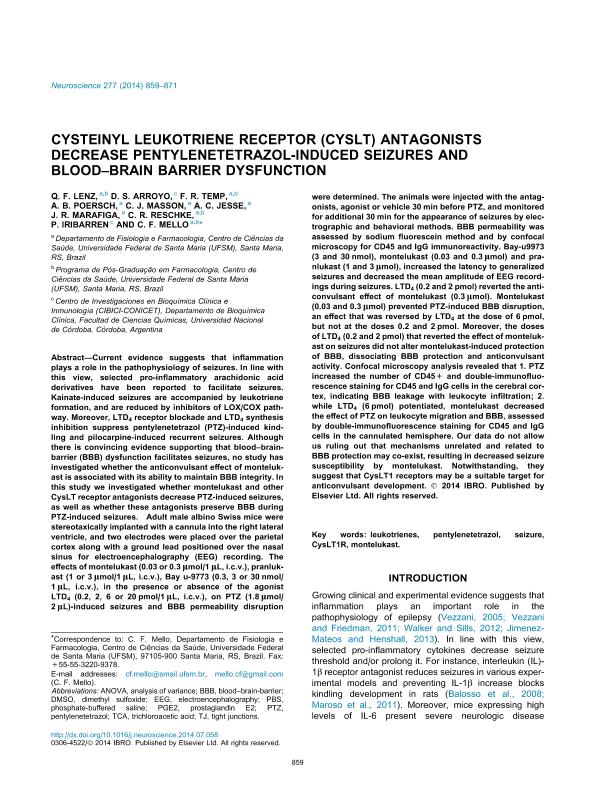Mostrar el registro sencillo del ítem
dc.contributor.author
Lenz, Q.F.
dc.contributor.author
Arroyo, Daniela Soledad

dc.contributor.author
Temp, F.R.
dc.contributor.author
Poersch, A.B.
dc.contributor.author
Masson, C.J.
dc.contributor.author
Jesse, A.C.
dc.contributor.author
Marafiga, J.R.
dc.contributor.author
Reschke, C.R.
dc.contributor.author
Iribarren, Pablo

dc.contributor.author
Mello, C.F.
dc.date.available
2018-01-02T14:56:14Z
dc.date.issued
2014-09
dc.identifier.citation
Mello, C.F.; Iribarren, Pablo; Reschke, C.R.; Marafiga, J.R.; Jesse, A.C.; Masson, C.J.; et al.; Cysteinyl leukotriene receptor (CysLT) antagonists decrease pentylenetetrazol-induced seizures and blood–brain barrier dysfunction; Pergamon-Elsevier Science Ltd.; Neuroscience; 277; 9-2014; 859-871
dc.identifier.issn
0306-4522
dc.identifier.uri
http://hdl.handle.net/11336/31960
dc.description.abstract
Current evidence suggests that inflammation plays a role in the pathophysiology of seizures. In line with this view, selected pro-inflammatory arachidonic acid derivatives have been reported to facilitate seizures. Kainate-induced seizures are accompanied by leukotriene formation, and are reduced by inhibitors of LOX/COX pathway. Moreover, LTD4 receptor blockade and LTD4 synthesis inhibition suppress pentylenetetrazol (PTZ)-induced kindling and pilocarpine-induced recurrent seizures. Although there is convincing evidence supporting that blood–brain-barrier (BBB) dysfunction facilitates seizures, no study has investigated whether the anticonvulsant effect of montelukast is associated with its ability to maintain BBB integrity. In this study we investigated whether montelukast and other CysLT receptor antagonists decrease PTZ-induced seizures, as well as whether these antagonists preserve BBB during PTZ-induced seizures. Adult male albino Swiss mice were stereotaxically implanted with a cannula into the right lateral ventricle, and two electrodes were placed over the parietal cortex along with a ground lead positioned over the nasal sinus for electroencephalography (EEG) recording. The effects of montelukast (0.03 or 0.3 μmol/1 μL, i.c.v.), pranlukast (1 or 3 μmol/1 μL, i.c.v.), Bay u-9773 (0.3, 3 or 30 nmol/1 μL, i.c.v.), in the presence or absence of the agonist LTD4 (0.2, 2, 6 or 20 pmol/1 μL, i.c.v.), on PTZ (1.8 μmol/2 μL)-induced seizures and BBB permeability disruption were determined. The animals were injected with the antagonists, agonist or vehicle 30 min before PTZ, and monitored for additional 30 min for the appearance of seizures by electrographic and behavioral methods. BBB permeability was assessed by sodium fluorescein method and by confocal microscopy for CD45 and IgG immunoreactivity. Bay-u9973 (3 and 30 nmol), montelukast (0.03 and 0.3 μmol) and pranlukast (1 and 3 μmol), increased the latency to generalized seizures and decreased the mean amplitude of EEG recordings during seizures. LTD4 (0.2 and 2 pmol) reverted the anticonvulsant effect of montelukast (0.3 μmol). Montelukast (0.03 and 0.3 μmol) prevented PTZ-induced BBB disruption, an effect that was reversed by LTD4 at the dose of 6 pmol, but not at the doses 0.2 and 2 pmol. Moreover, the doses of LTD4 (0.2 and 2 pmol) that reverted the effect of montelukast on seizures did not alter montelukast-induced protection of BBB, dissociating BBB protection and anticonvulsant activity. Confocal microscopy analysis revealed that 1. PTZ increased the number of CD45+ and double-immunofluorescence staining for CD45 and IgG cells in the cerebral cortex, indicating BBB leakage with leukocyte infiltration; 2. while LTD4 (6 pmol) potentiated, montelukast decreased the effect of PTZ on leukocyte migration and BBB, assessed by double-immunofluorescence staining for CD45 and IgG cells in the cannulated hemisphere. Our data do not allow us ruling out that mechanisms unrelated and related to BBB protection may co-exist, resulting in decreased seizure susceptibility by montelukast. Notwithstanding, they suggest that CysLT1 receptors may be a suitable target for anticonvulsant development.
dc.format
application/pdf
dc.language.iso
eng
dc.publisher
Pergamon-Elsevier Science Ltd.

dc.rights
info:eu-repo/semantics/openAccess
dc.rights.uri
https://creativecommons.org/licenses/by-nc-sa/2.5/ar/
dc.subject
Leukotrienes
dc.subject
Pentylenetetrazol
dc.subject
Seizure
dc.subject
Cyslt1r
dc.subject
Montelukast
dc.subject.classification
Inmunología

dc.subject.classification
Medicina Básica

dc.subject.classification
CIENCIAS MÉDICAS Y DE LA SALUD

dc.title
Cysteinyl leukotriene receptor (CysLT) antagonists decrease pentylenetetrazol-induced seizures and blood–brain barrier dysfunction
dc.type
info:eu-repo/semantics/article
dc.type
info:ar-repo/semantics/artículo
dc.type
info:eu-repo/semantics/publishedVersion
dc.date.updated
2017-12-28T17:46:38Z
dc.journal.volume
277
dc.journal.pagination
859-871
dc.journal.pais
Estados Unidos

dc.journal.ciudad
Oxford
dc.description.fil
Fil: Lenz, Q.F.. Universidade Federal de Santa Maria. Santa Maria; Brasil
dc.description.fil
Fil: Arroyo, Daniela Soledad. Consejo Nacional de Investigaciones Científicas y Técnicas. Centro Científico Tecnológico Córdoba. Centro de Investigaciones en Bioquímica Clínica e Inmunología; Argentina
dc.description.fil
Fil: Temp, F.R.. Universidade Federal de Santa Maria. Santa Maria; Brasil
dc.description.fil
Fil: Poersch, A.B.. Universidade Federal de Santa Maria. Santa Maria; Brasil
dc.description.fil
Fil: Masson, C.J.. Universidade Federal de Santa Maria. Santa Maria; Brasil
dc.description.fil
Fil: Jesse, A.C.. Universidade Federal de Santa Maria. Santa Maria; Brasil
dc.description.fil
Fil: Marafiga, J.R.. Universidade Federal de Santa Maria. Santa Maria; Brasil
dc.description.fil
Fil: Reschke, C.R.. Universidade Federal de Santa Maria. Santa Maria; Brasil
dc.description.fil
Fil: Iribarren, Pablo. Consejo Nacional de Investigaciones Científicas y Técnicas. Centro Científico Tecnológico Córdoba. Centro de Investigaciones en Bioquímica Clínica e Inmunología; Argentina
dc.description.fil
Fil: Mello, C.F.. Universidade Federal de Santa Maria. Santa Maria; Brasil
dc.journal.title
Neuroscience

dc.relation.alternativeid
info:eu-repo/semantics/altIdentifier/doi/http://dx.doi.org/10.1016/j.neuroscience.2014.07.058
dc.relation.alternativeid
info:eu-repo/semantics/altIdentifier/url/http://www.sciencedirect.com/science/article/pii/S0306452214006319
Archivos asociados
